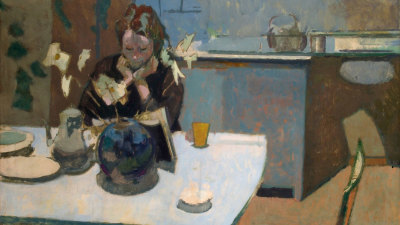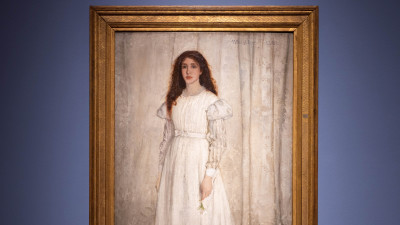Hidden from history: the Royal Academy’s female founders
Hidden from history: the Royal Academy’s female founders
By Amanda Vickery
Published 3 June 2016
While the past decade has seen more female artists becoming Academicians, they have been a rare sight for much of the RA’s existence, and were even excluded from Zoffany’s famed painting of the Academy’s founders. Historian Amanda Vickery delves into the archives to discover the pioneering women who wielded the brush.
-
From the Summer 2016 issue of RA Magazine, issued quarterly to Friends of the RA.
One painting in particular is infamous in the history of the representation of women in British art. If ever there was a commemoration of artistic fraternity, Johann Zoffany RA’s The Academicians of the Royal Academy, of 1771-72 (pictured), appears to be it. The recent foundation of the Royal Academy is memorialised in this group portrait of 35 men, two of them naked models, preparing to embark on a life class.
Remarkably, among the 34 founder members there were two women, Mary Moser (1744-1819) and Angelica Kauffman (1741-1807). Notoriously, however, Zoffany’s institutional portrait excluded them. They appear only virtually, in two indistinct portraits on the back wall to the right. Their physical absence is partially explained by the setting within the life class: a forum from which women were barred on grounds of propriety. Hence the painting is seen to epitomise the ambivalent recognition and conditional institutional support extended to female artists.
For most commentators, Zoffany’s painting provides a depressing confirmation that female institutional accreditation was grudging and tokenistic at best. Kauffman and Moser can also be seen in a later painting – Henry Singleton’s The Royal Academicians in General Assembly (1795). They are in the deep background of the assembled throng in the Council Room, though at the apex of the group. Nevertheless, Moser and Kauffman were not the first swallows of a summer of women RAs. After Kauffman’s return to Rome and Moser’s death, there were no further women Royal Academicians until Dame Laura Knight was elected in 1936.
-

Mary Moser RA, Summer, c.1780.
© Royal Academy of Arts, London / photo: John Hammond.
-
Women had gained a toehold in the institutions that preceded the Royal Academy. The Society for the Encouragement of Arts, Manufactures and Commerce (known as the Society of Arts) was established in 1754, with a mission to encourage innovation in agriculture, manufacture, chemistry, mechanics, polite arts, colonies and trade. In 1759, Moser – a daughter of an enamellist and then aged 14 – won a silver medal in the category of ‘Polite Arts’ for a painting of a vase of flowers, and several other women exhibited in sections on drawing, needlework and engraving in a small display. Art historian Marcia Pointon has suggested that the Society’s openness to industry may have encouraged women to enter from the applied arts end of the spectrum of trades.
After the Society of Arts came the Society of Artists, which held its first exhibition in 1760. Moser was one of only two women who appeared in this show of 130 works, which attracted around 1,000 visitors a day. Moser’s flower painting joined a portrait by Catherine Read. At the second annual exhibition in 1761, Moser was joined by a Mrs Cawardine and a Miss Charpin. In 1762, a Miss Grace, Miss Benwell and again Mrs Cawardine exhibited alongside Moser. In fact, Moser exhibited in nearly every show between 1760 and 1768 (11 works in all), then switched allegiance to the Royal Academy when it was founded. At just 24, she became the youngest founding Academician of the Royal Academy.
The decision to include Kauffman and Moser in the Royal Academy is poorly documented and subject to continuing speculation. There are no records of explicit debates on whether to include women or not, nor of complaints from the male majority on their presence. It is possible that Kauffman was seen to add a continental cachet to the fledgling Academy. She had already achieved a position of some prominence within the expatriate artistic colonies of Italy, impressing British painters, architects and Grand Tourists with her cultured persona and innovative Neoclassicism. Both Kauffman and Moser possessed the requisite credentials in history painting which, combined with a level of court favour and professional achievement, probably made them difficult to exclude.
The Instrument of Foundation of the Royal Academy addresses men, and uses the male pronoun throughout, but otherwise the Academy’s laws never explicitly excluded women. This was not an unusual circumstance of course. In the 18th century the hegemony of men was so deeply ingrained that it was not thought necessary to codify the exclusion of women from such institutions. After all, it was not until the Great Reform Act of 1832 that women were specifically banned from the vote.
-

Angelica Kauffman RA, Design, 1778-1780.
© Royal Academy of Arts, London / Photo: John Hammond.
-
Neither Kauffman nor Moser were admitted to the Council (the committee responsible for overseeing the Royal Academy) or to the Academy’s life drawing classes. They could play no role in the governance or direction of the Academy. In fact women were not invited to the Academy’s annual dinner until 1967. Nevertheless, the evidence of the archive suggests that Kauffman’s concerns were handled respectfully. When she wanted a painting removed on grounds of it being a scurrilous attack on her virtue, the RA obliged. The painting in question, Nathaniel Hone’s The Conjuror, was accepted for the Summer Exhibition in 1775. It was said to ridicule Kauffman’s alleged relationship with Joshua Reynolds PRA as it depicted Kauffman as a child leaning across Reynolds’s knee in front of a backdrop of prints, one of which shows naked figures dancing around St Paul’s Cathedral. Kauffman sent a letter to the President and Council in protest – and the painting was subsequently removed on the grounds that it was offensive to the Royal Academy’s female members.
In 1780, Kauffman was commissioned to produce four oval allegories for the ceiling of the Academy’s Council Room, representing Invention, Composition, Design (above) and Colour. She exhibited 79 works between 1769 and 1797, while Moser showed 36 between 1769 and 1802. A letter sent from Joseph Bonomi to Benjamin West PRA containing an account of Kauffman’s funeral in Rome was read aloud with great pomp at a meeting of the General Assembly in December 1807 and transcribed in full in the minutes. These two artists were nothing if not high profile.
They were not, however, alone on their platform. Scour the RA’s index of exhibitors and you’ll find a fair scatter of women designated ‘artist’. Eliza Cook, a ‘miniature painter’ listed at several London addresses, showed seven works between 1777 and 1786; Mary Bertrand, ‘painter’, exhibited 10 items between 1772 and 1800. Among the honorary exhibitors there are more works ‘by a young lady’. Mary Benwell, another ‘miniature painter’, showed 20 paintings before marrying, then showed 18 works as Mrs Code.
None of which suggests anything approaching equality of the sexes among the Membership. In 1777 for instance, by my count of the exhibition catalogues, of 190 exhibitors 15 were women (8 per cent) and of 364 paintings 27 were by women (7 per cent). Yet for all their minority status it is still striking that the female artists are there, and seem to be making a professional living, supported to a degree by the RA.
It is worth remembering that there were no equivalent institutional roles and platforms accessible to women in the fields of law, medicine, science, politics, local government, the universities, the Navy or the Army. The 18th century was the great era of associations, but women participated in only a tiny minority. They were excluded from the Linnean Society, the Society of Antiquaries and the Royal Society, the first female fellows being elected in 1904, 1921 and 1945 respectively. The only professional field in which women were seen to have made a public mark was in literature and letters. But the prominence of female novelists, translators, philosophers and polemicists in the late 18th century was founded on commercial success or nurtured by influential, informal networks, and owed little to institutions. So, by comparison, the fraternity of artists was open.
Amanda Vickery (@Amanda_Vickery) is a writer, presenter and Professor of Early Modern History at Queen Mary University of London
-
-
Enjoyed this article?
Become a Friend to receive RA Magazine
As well as free entry to all of our exhibitions, Friends of the RA enjoy one of Britain’s most respected art magazines, delivered directly to your door. Why not join the club?

-






